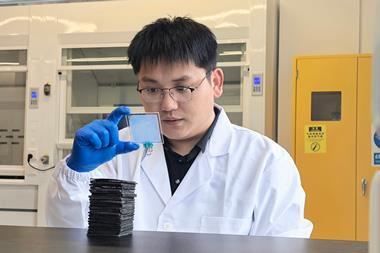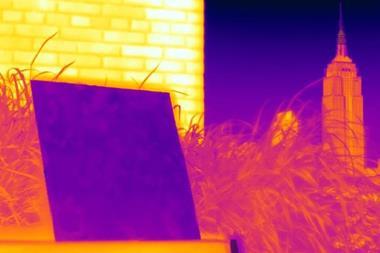Researchers in China claim to have produced a photoluminescent aerogel with a visible light reflectance of 104%. When placed outside in the sun, they found that the material could cool surfaces by up to 16°C below ambient temperature. Moreover, the material is self-healing, recyclable, compostable, and environmentally friendly. However, other researchers have expressed scepticism about several aspects of the researchers’ claims. They nevertheless believe the technology could have promising applications in paints.
As the Earth’s climate warms, the need to cool buildings becomes ever-more pressing. Researchers are therefore keen to develop cooling technologies that do not consume energy. In 2014, Aaswath Raman at Stanford University and colleagues produced a radiative cooling surface that was highly reflective at visible wavelengths – where the sun’s radiation peaks – but emissive in the mid-infrared, where warm bodies on Earth radiate.
In full sunlight, the surface stayed 5°C below ambient temperature. However, it comprised seven alternate layers of silicon dioxide and hafnium dioxide, each manufactured with nanometre precision. More scalable techniques have subsequently been developed involving two-layer polymer films, paints and cooling wood. All of these, however, have been unable to completely suppress photon absorption at visible wavelengths.
Unusual ingredients
In the new research, Jian-Wen Ma and colleagues at Sichuan University in Chengdu tackled this issue by developing a hydrogen-bonded aerogel from readily available biomass. They freeze-dried a solution of commercially obtained salmon sperm DNA and gelatin. Sublimation of ice crystals left a layered aerogel with high compressive strength. Density functional theory suggests it was held together by ionic hydrogen bonds between the phosphate groups in DNA and the hydroxyl and amino groups in gelatin. Simply wetting the material solvates these groups, allowing ‘water welding’ of the aerogel bricks into large sheets without heating or any toxic reagents. The same technique can be used to heal damage. At the end of its life the material can be recycled or composted.

In lab tests, the material absorbed very little light at visible and near-infrared wavelengths. UV photons, however, stimulated electronic excitations in the matrix, causing it to absorb in the ultraviolet. These excitations subsequently decayed radiatively, causing the aerogel to emit blue light. As a result, the reflectance in visible light measured by the researchers actually reached 104%. Meanwhile, the presence of a wide array of single and double bonds between carbon, oxygen, nitrogen and phosphorus within the matrix ensured a broad emissivity band above 90% in the infrared.
Further tests suggested that under sunny skies in Chengdu, the aerogel cooled surfaces by up to 16°C below the ambient air temperature. The researchers calculate that, if used as the outer layer in building materials, it could lower the energy required to cool the building by 69%.
War on thermodynamics
Other researchers, however, have expressed concerns about the findings. Raman, now at University of California, Los Angeles, says that ‘it is certainly an interesting material’, but he takes issue with the 104% reflectance figure. First, the lamps used in laboratory spectrophotometers contain far more ultraviolet light than present in sunlight, to the point that ‘it’s actually dangerous to put my hand in front of these UV lamps’, so he believes the visible photoluminescence from UV absorption is probably therefore increased.
He also says the figure has little meaning in isolation, ‘You cannot have a greater than 100% reflective material over the entire solar spectrum,’ he says. ‘You can play spectral games, but the number I’m looking for is: if I look over the whole solar spectrum, what is its reflectance? I don’t think they’ve reported that.’ He concludes: ‘I’m surprised this paper was published as it is.’
Ma responds that the researchers have performed the best measurements available with current equipment and strive to improve it further. He also notes that absorption is an intrinsic property of a material, so tuning a material so that UV light is re-emitted in the visible region reduces solar heat generation. ‘Visible and near-infrared light is more likely to generate heat than UV light,’ he adds.

Po-Chun Hsu of the University of Chicago predicts that this last statement, which is similar to one that appears in the paper, ‘will lead to some common discussion about their definition of energy conservation and whether this will really generate more cooling, because it sounds like a straight declaration of war on the first and second laws [of thermodynamics]’.
Raman and Hsu both believe, however, that the aerogel may have potential in materials that provide colour by absorbing visible light at one wavelength and re-emitting it at another. ‘They do have this very unique advantage to provide colour to radiative cooling materials if they can use emission to give you colour,’ says Hsu. Raman, however, notes this idea was first suggested back in 2016 by Paul Berdahl and colleagues at University of California, Berkeley.
Asked about the work, Berdahl, who has now retired, offers one observation: the researchers’ measurement that their surface cooled to 16°C below ambient temperature is predicated on the ‘ambient’ temperature being 47°C. Historical meteorological data do not show the temperature in Chengdu on the date listed having risen above 20°C. ‘Obviously the reference sensor is in the sun,’ says Berdahl.
References
J-W Ma et al, Science, 2024, 385, 68 (DOI: 10.1126/science.adn5694)

















No comments yet